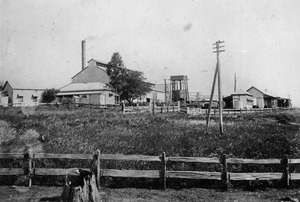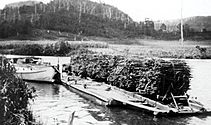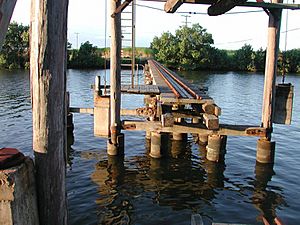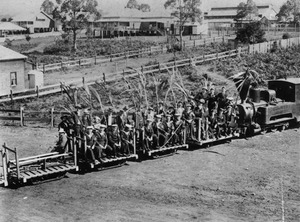Moreton Central Sugar Mill Cane Tramway facts for kids
Quick facts for kids Moreton Central Sugar Mill Cane Tramway |
|
|---|---|
| Lua error in Module:Location_map at line 420: attempt to index field 'wikibase' (a nil value). | |
| Location | Mill Street, Currie Street, Howard Street, Nambour, Sunshine Coast Region, Queensland, Australia |
| Design period | 1870s - 1890s (late 19th century) |
| Built | c. 1897 |
| Official name: Nambour Section of the Moreton Central Sugar Mill Cane Tramway | |
| Type | state heritage (built) |
| Designated | 7 February 2005 |
| Reference no. | 602522 |
| Significant period | 1897-onwards (fabric) 1897- 2003 (historical use of line) |
| Significant components | tramway |
The Moreton Central Sugar Mill Cane Tramway is a special heritage-listed tramway. You can find it on Mill Street, Currie Street, and Howard Street in Nambour, Queensland, Australia. This tramway was built around 1897. It was added to the Queensland Heritage Register on 7 February 2005 because of its historical importance.
Contents
History of the Cane Tramway
The Moreton Central Sugar Mill started crushing sugar cane in 1897. The tramway system was built over many years. It connected the mill to the farms where sugar cane grew. This tramway was used until late 2003. It was super important for the mill's success. It also helped Nambour grow into the town it is today.
Early Sugar Growing in Queensland
Sugar cane first came to Australia in 1788. But it wasn't until 1862 that Captain Louis Hope successfully grew it in Queensland. By 1864, the first commercial sugar mill in Australia opened. It was at Ormiston. Growing sugar cane quickly became popular. The Queensland Government encouraged it.
By 1867, about 2,000 acres of land near Brisbane had sugar cane. Later, cane was also grown further north. Places like Maryborough, Mackay, and Bundaberg had warmer weather. This climate was much better for sugar cane.
Sugar Mills in the Nambour Area
In the 1860s, William Clark tried growing sugar cane near Bli Bli. Later, a group of Quakers planted cane near the Mooloolah River. They even built a small mill. But floods in the 1870s stopped their project.
However, sugar cane grew well in other areas. In Buderim, Joseph Chapman Dixon built a mill in 1876. He processed his own cane and cane from nearby farms. Another mill, the Buderim Mountain Sugar Mill, opened in 1881. But both these mills closed by the end of the 1880s.
Building the Moreton Central Sugar Mill
In 1893, a new law helped farmers build their own mills. This law provided money for central sugar mills. So, in December 1894, the Moreton Central Sugar Mill Company was formed. They bought land in Nambour for the mill. Building the mill started in late 1895.
For the mill to work, cane needed to get there fast. Tramways using steam locomotives were already used in other sugar areas. So, the Moreton Mill planned its own tramway. They chose a narrow "two-foot gauge" track. This was cheaper to build. At first, horses pulled the wagons. In 1897, the first tramlines were built. They went east and west from the mill. The first sugar harvest was crushed that year.
Expanding the Tramway Network
Building tramways was costly because of the hilly land. This made it hard to get enough cane to the mill. By 1905, there were 26 miles of permanent tramline. The Queensland government even ran the mill for a few years.
In 1905, the mill bought its first steam locomotive. But horses still helped deliver cane on some lines. In 1911, a new line went to the Maroochy River. Some western lines were sold to Maroochy Shire in 1914. These lines were later bought back by the mill in 1945.
More lines were built, but World War I caused problems. There wasn't enough steel or workers. Many lines were temporary, only used during the crushing season. In 1917, a lift bridge was built over Petrie Creek. In 1921, the Tramway Lift Bridge over Maroochy River was built. This bridge connected northern cane farms to the tramway. The line was extended to Coolum Beach in 1922. It officially opened in 1923.
The Tramway and Tourism
The road to Coolum was often muddy and hard to use. The tramway became a popular way to travel. The mill's tramway station in Nambour was near the main train station. People from Brisbane could take the tramway to Coolum. They could also connect to a boat to Maroochydore.
The mill even put seats in the cane wagons for passengers. They timed the trams to match train schedules. This service was very popular. It helped Coolum become a seaside resort. Land in the Mt Coolum Beach Estate went up for sale soon after the tramway opened. A better road was built in 1927. The tramway passenger service to Coolum stopped in 1935 when buses took over.
Changes and Closure
Work on the mill and tramway continued in the 1930s. During World War II, operations slowed down. There were fewer ships and not enough workers. After the war, the mill bought back some lines. In the early 1950s, many repairs were done. In 1961, the mill bought diesel locomotives. This meant bridges had to be made stronger. Heavier rails were also laid.
Until 2003, during harvest season, cane bins were pulled through Nambour. They entered the mill on Mill Street. The bins went into a "full yard." Then, machines pushed them to empty the cane. After that, they went back to the fields.
In 1976, Howard Smith took over the mill. They made big improvements. In 1987, the mill was sold to Bundaberg Sugar. The company name changed to Moreton Sugar Company Limited in 1991. Later, a Belgian company, Finasucre, bought the mill in 2000.
Between 1980 and 2003, a lot of cane land was used for buildings. This meant some cane had to travel 60-70 km to the mill. Cane needs to be crushed soon after harvesting. Long travel times affected the sugar content. The price of sugar also dropped. The Moreton Mill closed on 3 December 2003. Most of the tramline was removed. But the section in Nambour stayed. It shows how the tramway was used for cane and passengers. It's a special part of Nambour's history.
What the Tramway Looks Like
The cane tramway is built right into the middle of the road. It runs through the main part of Nambour. It's a narrow, 2-foot wide track. It goes from the old mill site on Mill Street. Then, it crosses the Currie Street intersection. Finally, it goes down Howard Street to the marshalling yards.
Why it's a Heritage Site
The Nambour Section of the Moreton Central Sugar Mill Cane Tramway was added to the Queensland Heritage Register on 7 February 2005. This means it's a very important historical place.
Showing Queensland's History
The Moreton Central Sugar Mill operated from 1897 to 2003. Sugar growing was the most important industry in the Maroochy area for a long time. The mill and its tramway helped Nambour and the Maroochy Shire grow. They were also important for the sugar industry in Queensland. The tramway brought cane from many farms to the mill. It was a key part of the mill's work.
The line between Nambour and Coolum also carried passengers in the 1920s and 30s. This helped tourism grow in the area. It connected the Nambour train station to popular places like Coolum and Maroochydore.
A Rare Part of History
It's very unusual for a cane tramway to go right through the middle of a town, like the one in Nambour does. This makes it quite rare. But it also shows what these types of tramways were like. It's a narrow track that connected the mill to the marshalling yards. From there, many lines spread out to farms, roads, and even over the Maroochy River.
Showing What it Was Like
Even though it's rare to see a cane tramway in a town center, this line shows the main features of its kind. It's a narrow gauge (2-foot) track. It was laid without much special preparation. It linked the mill to the yards. From these yards, the tramway spread out. It formed a big network across farms, roads, and over the Maroochy River.
Important to the Community
The part of the tramway that goes through Nambour is a special feature of the town. Pictures of cane trains moving between Nambour's shops were often on postcards. Tourists loved seeing them. It was also a big part of the yearly cane harvest festivals until recently.
Images for kids







